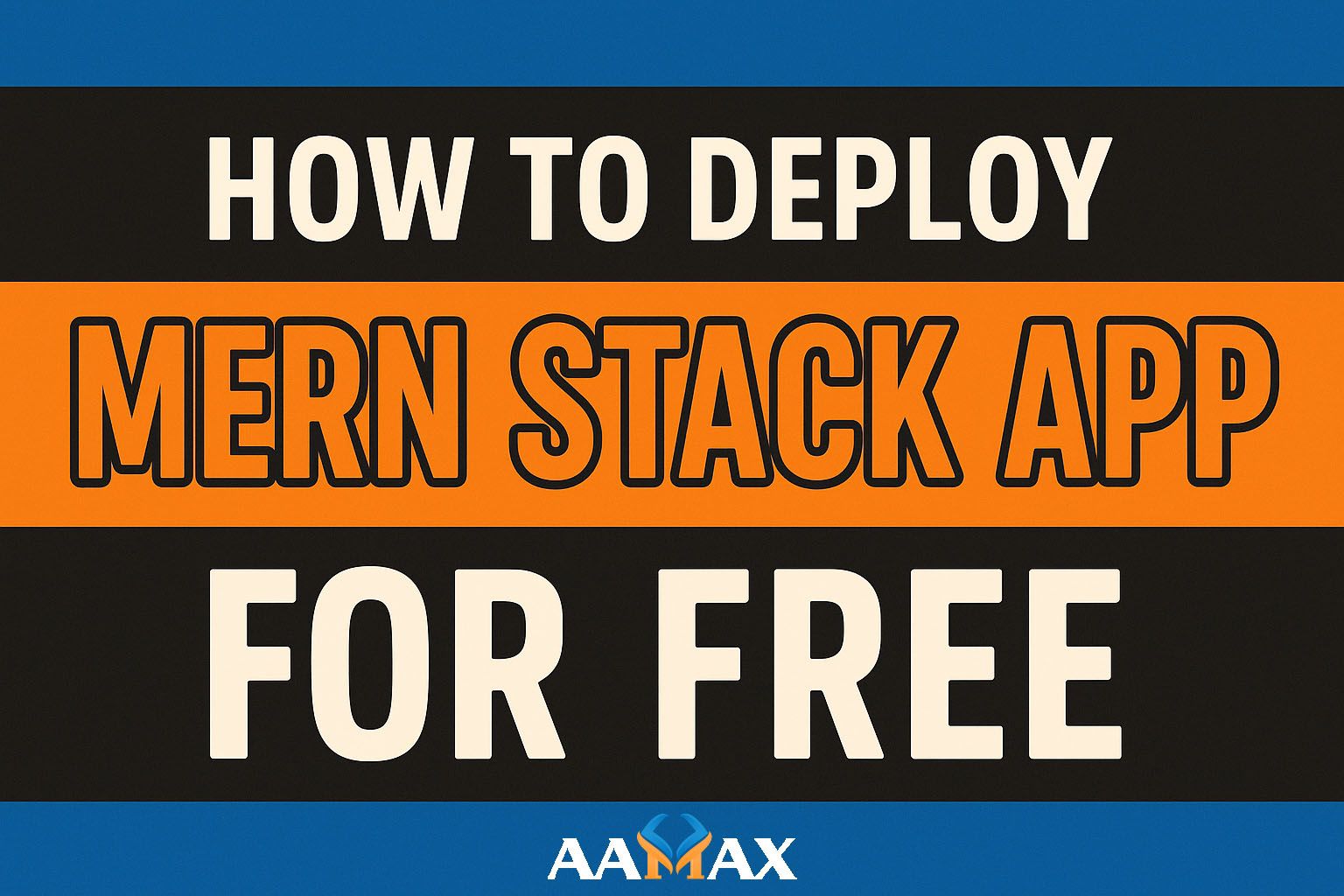
How To Deploy MERN Stack App for Free
Modern cloud platforms offering free tiers, even beginners can deploy full‑stack applications without paying a cent. In this comprehensive guide, you'll learn multiple strategies and platforms to deploy your MERN app for free---along with useful best practices, optimization tips, and troubleshooting guidance. By the end, you'll be ready to take your project live with confidence.
If you need professional help creating or deploying your MERN application, you can hire AAMAX, a full‑service digital marketing agency specializing in Web Development, Digital Marketing, and SEO Services.
What is the MERN Stack?
The MERN stack is a popular full‑stack development framework composed of four core technologies:
- MongoDB -- A NoSQL database used to store application data in JSON format.
- Express.js -- A backend web application framework running on Node.js.
- React -- A frontend JavaScript library used to design user interfaces.
- Node.js -- A JavaScript runtime environment for executing backend code.
Together, these components enable developers to build scalable, modern applications using JavaScript on both the client and server sides.
Why Deploy a MERN App for Free?
Deploying your MERN app for free is useful when:
- You're prototyping an idea.
- You're building a portfolio project.
- You're learning full‑stack development.
- You're running a small‑scale MVP.
- You want to test deployment pipelines before scaling.
Free deployment does not always mean limited capability---many platforms offer reasonable levels of performance, security, and reliability.
Core Requirements Before Deployment
Before deploying, ensure you have:
- A MERN project ready (React frontend + Node/Express backend).
- Source code hosted on GitHub (recommended).
- Environment variables prepared (MongoDB URI, API keys).
- npm scripts (
start&build) properly set up. - A MongoDB database (local or cloud‑hosted---MongoDB Atlas recommended).
Step‑by‑Step Guide: Deploying MERN on Render (Free)
Render is a popular cloud platform that supports free hosting for both backend and static sites.
Step 1 --- Prepare MERN Project
Make sure your project has the correct structure:
/client
/server
Step 2 --- Host MongoDB on MongoDB Atlas
- Create a MongoDB Atlas account.
- Create a new cluster.
- Whitelist all IPs.
- Copy the connection URI.
- Store it for environment configuration.
Step 3 --- Deploy Backend on Render
- Push your
servercode to GitHub. - Log in to Render.
- Click New Web Service.
- Connect GitHub repo.
- Add build command:
<!-- -->
npm install
6. Add start command:
<!-- -->
npm start
7. Add environment variables (MONGODB_URI, PORT, etc.).
8. Deploy.
Render will assign a backend URL.
Step 4 --- Deploy Frontend on Render
- Push your
clientfolder to GitHub. - Create a static site.
- Build command:
<!-- -->
npm install && npm run build
4. Publish directory:
<!-- -->
build
5. Add environment variable REACT_APP_API_URL to point to backend.
Step 5 --- Test & Validate
- Ensure backend routes are working.
- Ensure frontend connects to backend.
Your MERN app is now live!
Deploying MERN App on Vercel (Frontend + Backend)
Vercel is the simplest platform for frontend hosting, but backend requires serverless functions or external deployment.
Deploy Backend on Render or Railway
Follow previous steps---get backend URL.
Deploy Frontend on Vercel
- Log in to Vercel.
- Import GitHub project.
- Add
REACT_APP_BACKEND_URL. - Deploy.
Configure CORS
Ensure CORS on backend:
const corsOptions = {
origin: "*",
methods: "GET,POST,PUT,DELETE"
};
Deploying MERN on Railway
Railway supports Node.js hosting with free tiers.
Steps
- Connect GitHub.
- Add MongoDB variable.
- Deploy.
- Connect frontend separately.
Railway autogenerates environment variables and domain.
Deploy MongoDB Atlas
MongoDB Atlas offers a free tier database.
Steps:
- Create project.
- Build cluster.
- Configure security.
- Connect via URI.
Example connection:
mongodb+srv://username:password@cluster.mongodb.net
Environment Variables
Use .env for sensitive credentials:
PORT=5000
MONGO_URI=YOUR_URI
JWT_SECRET=SECRET
On deployment platforms, store these via Settings → Env Vars.
Useful File Setup
Client package.json
"build": "react-scripts build",
"start": "react-scripts start"
Server package.json
"start": "node server.js",
"dev": "nodemon server.js"
Handling CORS
Enable frontend to access backend:
import cors from "cors";
app.use(cors());
Folder Structure Best Practices
/client
/server
/controllers
/models
/routes
.env
README.md
Common Deployment Issues & Fixes
Issue Fix CORS errors Configure CORS Build fails Check dependencies API not working Check env vars React not loading Correct build folder MongoDB fails Whitelist IP
Optimizing Your MERN App for Production
- Use
compressionmiddleware in Node. - Use HTTPS where possible.
- Minify build.
- Monitor logs.
- Use global error handling.
Free Hosting Platforms Compared
Platform Backend Frontend DB Free Tier Render ✅ ✅ ❌ ✅ Vercel ⚠️ ✅ ❌ ✅ Railway ✅ ✅ ❌ ✅ MongoDB Atlas ❌ ❌ ✅ ✅
Security Checklist
- Keep secrets private.
- Validate user input.
- Use HTTPS.
- Avoid too many public IPs.
- Disable dangerous permissions.
Testing Your Live MERN App
Use:
- Postman
- cURL
- Browser dev tools
Verify:
- APIs return correct data.
- Frontend displays backend data.
- Errors logged properly.
When to Scale Up
Move to paid hosting when:
- High traffic.
- Mission‑critical application.
- Require guaranteed uptime.
- Need custom SSL certificates.
- Need multiple databases.
Conclusion
Deploying a MERN stack app for free is very achievable using platforms like Render, Vercel, Railway, and MongoDB Atlas. These tools allow you to deploy applications, test prototypes, and showcase your work without spending money. As your project grows, you can gradually transition to paid plans for enhanced performance and security.
Need expert development help? Hire AAMAX for MERN Stack Development and other digital services including Web Development, Digital Marketing, and SEO.







